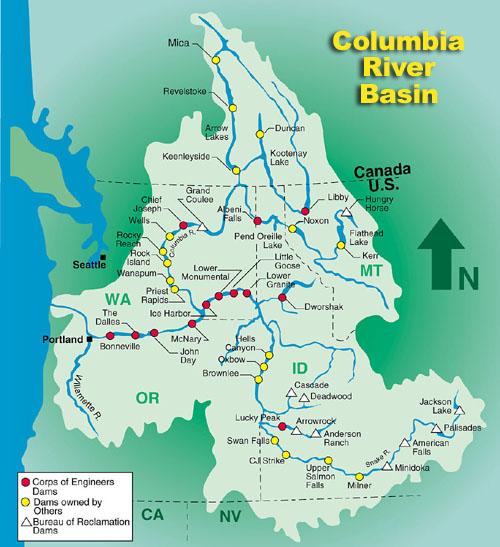
The Columbia River Basin is North America's fourth largest,
draining about 250,000 square miles and extending throughout the Pacific
Northwest and into Canada. There are more than 250 reservoirs and
around 150 hydroelectric projects in the basin, including 18 mainstem
dams on the Columbia and its main tributary, the Snake River.
The US Army Corps of Engineers operates nine of 10 major federal projects on the Columbia and Snake rivers, and Dworshak Dam on the Clearwater River, Libby Dam on the Kootenai River, and Albeni Falls Dam on the Pend Oreille River. The federal projects are a major source of power in the region, and provide flood damage reduction, navigation, recreation, fish and wildlife, municipal and industrial water supply, and irrigation benefits.
 Dams and Salmon
Dams and Salmon
The Corps operates a series of eight dams on the lower Columbia and Snake rivers that affect the habitat and migration of anadromous salmon and steelhead species. These are Bonneville, The Dalles, John Day and McNary on the lower Columbia; and Ice Harbor, Lower Monumental, Little Goose and Lower Granite on the lower Snake River. The dams impede juvenile and adult migrations to and from the ocean by their physical presence and by creating reservoirs. The reservoirs behind the dams slow water velocities, alter river temperatures, and increase predation potential. Reduced water velocity increases the time it takes juveniles to migrate downstream, higher water temperatures may have adverse effects on juvenile and adult behavior, and predators find prey more easily in slower-moving water. However, all eight of these dams have juvenile and adult fish passage facilities to enable fish to migrate past the dams; and, the dams are operated to improve passage as well as reservoir conditions for fish.
--------------------
from US Army Corps of Engineers who set up and built most of the dam system of the Columbia R.
The US Army Corps of Engineers operates nine of 10 major federal projects on the Columbia and Snake rivers, and Dworshak Dam on the Clearwater River, Libby Dam on the Kootenai River, and Albeni Falls Dam on the Pend Oreille River. The federal projects are a major source of power in the region, and provide flood damage reduction, navigation, recreation, fish and wildlife, municipal and industrial water supply, and irrigation benefits.
 Dams and Salmon
Dams and SalmonThe Corps operates a series of eight dams on the lower Columbia and Snake rivers that affect the habitat and migration of anadromous salmon and steelhead species. These are Bonneville, The Dalles, John Day and McNary on the lower Columbia; and Ice Harbor, Lower Monumental, Little Goose and Lower Granite on the lower Snake River. The dams impede juvenile and adult migrations to and from the ocean by their physical presence and by creating reservoirs. The reservoirs behind the dams slow water velocities, alter river temperatures, and increase predation potential. Reduced water velocity increases the time it takes juveniles to migrate downstream, higher water temperatures may have adverse effects on juvenile and adult behavior, and predators find prey more easily in slower-moving water. However, all eight of these dams have juvenile and adult fish passage facilities to enable fish to migrate past the dams; and, the dams are operated to improve passage as well as reservoir conditions for fish.
--------------------
from US Army Corps of Engineers who set up and built most of the dam system of the Columbia R.
No comments:
Post a Comment